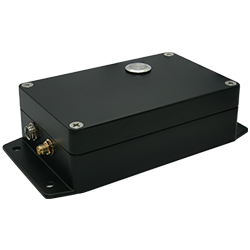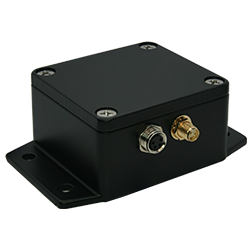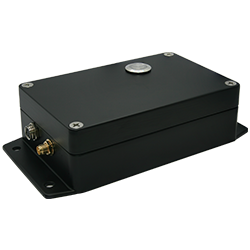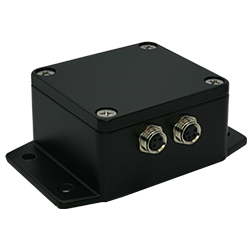The Nexus System consists of a central industrial cellular gateway and a variety of nodes connected over a customized wireless network. The number and variety of nodes can be selected to suit the application, making the system highly flexible. The wireless link is either a customized Thread network or long-range Wi-Fi HaLow. The gateway communicates with cloud servers over a CAT-1 cellular modem with plenty of bandwidth for live monitoring.
Standard nodes include an RS-485 / RS-232 serial node, an accelerometer node, a current and temperature monitoring node, and a sensor hub node supporting multiple analog and digital inputs. Custom nodes can be developed for specific applications.
This plug-and-play approach allows the system to be tailored to specific applications using standard, off-the-shelf components. This means faster time to market and lower cost with little to no custom hardware or embedded software development.
Housed in rugged aluminum enclosures, the industrial cellular gateways and sensor hubs are designed for harsh outdoor and industrial environments.

The Nexus Industrial cellular gateway and router is designed for industrial and outdoor applications. It is designed as a communications hub, able to connect to a variety of sources and link them to cloud servers for bidirectional monitoring and control. It is the central hub of the Nexus System, connecting a variety of SensePoint sensor nodes to the Internet.
The Nexus Panel is a small, industrial panel cellular gateway designed for industrial panel applications. RS-485 and USB ports allow it to connect to a wide array of PLCs, controllers, sensors and other equipment for real-time bidirectional monitoring and control. A single digital input can be used as an alarm or trigger and a single digital output can be used for signaling external devices.
The SensePoint Industrial wireless sensor hub combines the readings from multiple sensors and wirelessly sends them to a cellular gateway for transmission to the cloud. From there, the data is graphed, analyzed and acted upon. It has twelve inputs for sensors. These include four 4-20mA analog inputs, four 0-24V analog inputs, and four digital on/off inputs that can accept up to 24V. Also, it has a single Dallas 1-Wire channel for digital sensors.
The SensePoint CAN remote wireless CAN interface is a very small device that connects to a CAN bus on a device. It monitors messages on the bus and sends the values to a gateway for transmission to the cloud. It has 32 message filters to identify specific messages that need to be monitored. Also, it receives messages from the cloud for transmission on the bus. It connects to vehicles, controllers, PLCs and industrial equipment.
The SensePoint Motor wireless sensor hub verifies the health of electric motors by monitoring the motor currents and temperatures of various components. The readings from the sensors are wirelessly sent to a cellular gateway for transmission to the cloud. From there, the data is graphed, analyzed and acted upon. It has three 1V Current Transformer (CT) channels for monitoring electric current on each motor phase. It also has eight PT100 RTD channels for temperature monitoring. A single optoisolated input monitors contact closures or alerts from the motor or motor controller. A digital pulse input monitors switches or pulse sensors, such as flow meters.
The SensePoint Serial wireless RS-485 and RS-232 interface is a very small device that connects to the serial port on a piece of equipment. It has one RS-485 and one RS-232 channel to communicate with controllers, PLCs, or sensors. It connects to a Nexus Industrial or Nexus Panel cellular gateway over a wireless link. This system passes serial commands and data back and forth from a cloud server to the connected equipment. As an example, a Modbus register map is sent to the SensePoint Serial and the values in those registers is reported to the server.






